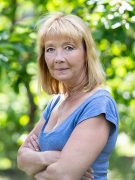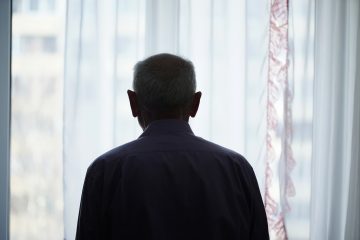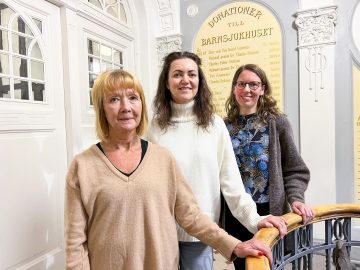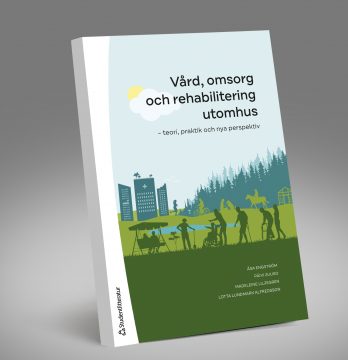RESEARCH WITH IMPACT. There are no rules governing access to the outdoors and nature experiences for older adults at residential care facilities in Sweden. The University of Gothenburg, Chalmers University of Technology, and Swedish University of Agricultural Sciences are conducting a joint research project that includes surveying the availability of outdoor environments for all residential care facilities in Sweden.
The research project is part of the Gothenburg Research School of Health Engineering (GRSHE), a collaboration among the University of Gothenburg, Chalmers University of Technology, and Sahlgrenska University Hospital. Recently a TV4 News feature (in Swedish) described the project.
Madeleine Liljegren is a double degree PhD student at the University of Gothenburg and Chalmers University of Technology. She is a physiotherapist, specialist in elderly health, has a master’s degree in landscape architecture and clinical experience from residential care facilities. Together with her supervisor, Helle Wijk–a nurse, professor at the University of Gothenburg, and visiting professor at Chalmers University of Technology–she is conducting a research project on outdoor environments at residential care facilities. The project also includes supervisors Göran Lindahl, an architect and professor at Chalmers University of Technology, and Anna Bengtsson, a landscape architect and associate professor at the Swedish University of Agricultural Sciences in Alnarp.
Consideration of the health of older adults

The project, focusing outdoor environments, is at the intersection of health sciences, architecture, and landscape architecture. To develop health-promoting outdoor environments that consider the needs and wishes of older adults, we need all three of these perspectives.
“I know how good it makes me feel to get outdoors for a while and take a break. About ten years ago, when I was working as a physiotherapist at residential care facilities, I began to wonder why I so rarely saw the older adults outdoors,” says Madeleine Liljegren.
This sparked her curiosity to explore the area further. After studies at the Swedish University of Agricultural Sciences in Alnarp , focusing outdoor environments in a health care context, she did a degree project on how the outdoor environment can serve as a care environment for older adults at residential care facilities, from the perspectives of physical activity and fall prevention.

“From a physiological point of view, outdoor stays have also been shown to have beneficial effects on human health. Being outdoor for a while during the day has positive effects on sleep, time orientation, appetite, the skeleton, pulse, blood pressure, and mobility,” Helle Wijk says.
The outdoor environments as a complement
For physiotherapist Madeleine Liljegren, outdoor environments are a valuable asset not only to provide older adults with the opportunity to outdoor stays, but also during rehabilitation for persons with physical disabilities:
“The outdoor environment complement the indoor environment. To have a meaningful everyday life, people need to be able to choose where in the physical environment they want to be, indoors or outdoors,” says Madeleine Liljegren. “Traditionally, rehabilitation has been done indoors where the surface is flat. But people also need to have access to rehabilitation in environments that place increased demands on their functional capacity and that are common environments in everyday life. Creating safety settings and minimizing the risk of fall accidents are the keys. The outdoor environment offer a variety of surfaces, such as asphalt, curbs, grass, gravel, and variation in the slope of the ground, qualities that cannot be replicated indoors.”
Access to the outdoor environment

The first part of Madeleine Liljegren’s thesis focuses on mapping the availability of outdoor environments at residential care facilities at a national level.
Madeleine Liljegren says: “Not having the opportunity to be outdoors can lead to a feeling of being locked in, which can have a negative impact on health.”
In collaboration with the National Board of Health and Welfare, the researchers have compiled a national list of all residential care facilities (a total of about 2,000 facilities) and requested architectural drawings for these facilities from the municipalities’ building permit units (a total of 290 municipalities). Two research assistants help analyze the drawings based on four identified zones of contact with the outdoor environment: zone 1 (experiencing contact with outdoor from the inside through windows); zone 2 (having access to a patio or balcony); zone 3 (the facility has its own outdoor environment adjacent to the building); and zone 4 (there are green areas in the surroundings). The study is time-consuming, and the researchers expect preliminary results to be available in a year.

Evidence-based guideline
An important goal of the dissertation is to ensure that more older adults at residential care facilities can choose to spend time outdoors as a complement to time spent indoors. One of the substudies aims to develop an evidence-based guideline of important qualities for the outdoor environment. According to the plan, the guideline will then be transformed into an evidence-based working method for the design, planning, and evaluation of outdoor environments in a subsequent substudy. The working method is intended to support professionals involved in the design of these environments. Various interest groups and authorities have become involved in the project, including the Swedish National Board of Housing, Building, and Planning. For example, this authority has recommendations for the size of outdoor environments in preschools and schools–recommendations that are lacking for outdoor environments at residential care facilities, hospitals, and health care centers.
“Older adults at residential care facilities have the right to a good environment that promotes health. Being able to move between indoor and outdoor environments also affects opportunities for socializing,” says Helle Wijk.
The project focusing outdoor environments is funded in part by the Kamprad Family Foundation, which has requested to follow one of the projects it funds more closely than usual. As a result, the researchers maintains a blog where the project’s progress is described regularly throughout the project period (2021–2025): link.
New book about outdoor health care and rehabilitation

Madeleine Liljegren and Helle Wijk are two of the 58 authors behind the recently published book Vård, omsorg och rehabilitering utomhus – teori, praktik och nya perspektiv (“Outdoor Health Care and Rehabilitation – Theory, Practice, and New Perspectives”). The book focuses on how outdoor environments can be used in health care and rehabilitation contexts in facilities such as residential care facilities, hospitals, and health care centers. The book summarizes the current evidence, provides current examples of how elements of nature and outdoor environments can be used in practice, and paints a picture of the future.
This is the first Swedish textbook to describe how physical outdoor environments can be used as a complement to indoor environments in health care, medical care and rehabilitation. It is intended for students, professionals, and policymakers in health care, medical care, and rehabilitation. Professionals in the design, construction, and management of outdoor environments and staff within animal husbandry and nature conservation may also find the book of interest.
Offers good examples
The book describes both the theoretical and practical background for successful outdoor initiatives in regional, municipal, and private contexts.
Considerable evidence indicates that contact with nature, daylight, and outdoor stays is beneficial to health, but using the outdoor environment for health care and rehabilitation has not yet been fully accepted in Sweden. A good example that the book highlights from the regional context is the intensive care unit at Ryhov Hospital in Jönköping. The hospital has developed an outdoor environment to allow the frailest persons to spend time outdoors, still connected to all the technologically advanced monitoring equipment that their conditions require. Other examples come from municipal activities and initiatives involving rehabilitation gardens and forests. The book also focuses on including animals, such as dogs, in initiatives targeting persons with special needs.
Read further about the project OUT-FIT: https://www.gu.se/forskning/out-fit
BY: ELIN LINDSTRÖM











